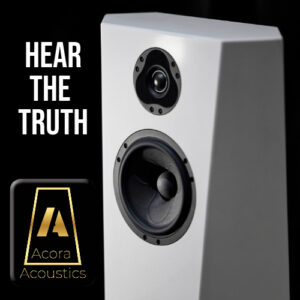It’s really nice to be first and right. In 2019 when I first heard a pair of Acora Acoustics (linked here) loudspeakers, I felt like I had stumbled onto something dramatically different from the rest of the pack. And no, it wasn’t just because the speakers were made from a few hundred pounds of solid granite. As you already know, the rest of the high-end (and low-end) speaker market almost exclusively turns to MDF when choosing an enclosure construction material. You know, that composite wood-waste panel mostly known for being used in kitchen cabinets? Yeah, that stuff.
Reporting by Eric Franklin Shook
Acora Acoustics founder and chief designer Valerio Cora is no stranger to high-end loudspeakers, or designing his own loudspeakers over the course of twenty-five plus years in the hobby. If there’s a loudspeaker of noteworthy historical audiophile canon, he’s likely owned a pair. When it was time for Valerio to finally bring to market his own dream loudspeaker, he turned to a material he knew intimately — granite.

A detail of note: It wasn’t until recently that manufacturing technology allowed the kind of high-tolerance craftsmanship that we see in Acora loudspeakers. The process of machining and constructing an enclosure like the one Acora Acoustics does, is both costly and demanding on the tools needed to fabricate its components. Only the brave may pass, only the saavy may succeed.

Now, let’s talk about being right.
First, or early, fine. I needed someone of the highest rank and order of magnitude better than myself to confirm my assumptions and testimony about Acora Acoustics loudspeakers, specifically the then flagship SRC-2. I tapped a recent friend, and a long time recording, mixing, and mastering professional from the competitive market — you know him as Dave McNair — a co-founder of this INDULGR concept.
Dave’s decades-long experience in music production has garnered him numerous Grammys, and a reputation among music industry giants worldwide, as one of the go-to-guys in his craft. In short order a review was underway, and with my own guidance as a hi-fi industry professional (whatever that means) a small consensus was formed. The Acora Acoustics SRC-2 had climbed to the summit of everything we’ve ever known about reproduction. It was awarded accordingly.

I’ll skip over the murmur of boos, jealousy, and overall negativity that this market disruption set upon Acora Acoustics, and even myself from the rest of the audiophile press, whom for their own agenda, were happier with the status quo.
Them: “He hasn’t paid his dues!”
Me: “What fucking dues?”
Time passes, and Mr. Cora informs Dave McNair and the rest of us (Grover Neville, Jameson Mourafetis, and myself) that a new flagship loudspeaker is on the horizon, still in prototype stage, and if any of us would like to preview it, that gift shall be granted. Both Dave and Grover find openings in their calendar and when they return, the reports are other-worldly.
Grover: “You know what the SRC-2 does to all other speakers?”
Me: “Yes. Destroys them.”
Grover: “Exactly. The new VRC is that same order of magnitude better than the SRC-2.”

The VRC at Florida Audio Expo
In February of 2022, Acora Acoustics set the world on fire with their SRC-2 and VAC tube amplifier exhibit. Dominating a room large enough to host a professional sporting event. Everyone remembers it.
Come February of 2023, and the new VRC does something almost unmatched elsewhere in audiophile history. It takes the goalpost and moves it so far down the road, that what was once considered true high-end, is in real danger of being demoted to “bespoke mid-fi.”
I’m sure you’ll read reports about how the building crumbled around the new VRC’s bass output or how Valerio has finally arrived. But the reality is, the truth can’t be ignored. That’s the story. At least for us.
And, don’t you ever doubt us again.

The System
- Acora Acoustics VRC ($220k pair)
- VAC 452 ($75k each)
- VAC Statement Line Stage ($80k)
- VAC Statement Phono ($80k)
- Oracle Delphi Reference ($13,920 with the Turbo Mk2 PSU)
- Reed 1H 9.5″ tonearm ($3,750)
- Lyra Atlas Lambda Cartridge ($11,995)
- Aurender N30SA Streamer ($25k)
- Aurender MC20 Rubidium Master Clock ($30k)
- Lampizator Horizon DAC ($50k)
- Cardas Cables throughout
- Racks by Acora Acoustics





































